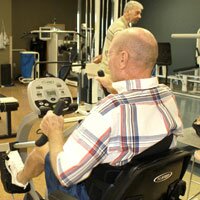Increasing Odds for Improvement after Hip Fracture

Hip fracture is not just a potentially disabling injury; it can be deadly, especially in the elderly.
Our hospital’s team approach to hip fracture rehabilitation applies a powerful combination of resources, leading rehabilitation technology and specialized experience. Strength and mobility increase. Future health problems are prevented. And, hope is restored.
Overview
Hip Fractures
The risk for hip fracture increases dramatically after age 50. Recovery can be challenging – and nearly impossible without aggressive rehabilitation. Rehabilitation guides the fractured hip victim through a long-term plan of care that greatly increases the odds of recovery.
Prevention
According to the American Academy of Orthopedic Surgeons, hip fractures are caused by a variety of factors that weaken bone and are often caused by the impact from a fall. The common characteristics in persons who are vulnerable to hip fractures are:
- Age - the rate increases for people 65 and older.
- Gender - women have two to three times as many hip fractures as men.
- Heredity - a family history of fractures in later life, particularly in Caucasians and Asians.
- A small-boned, slender body.
- Nutrition - a low calcium dietary intake or reduced ability to absorb calcium.
- Personal habits - smoking or excessive alcohol use.
- Physical impairments - physical frailty, arthritis, unsteady balance and poor eyesight.
- Mental impairments - senility, dementia, e.g., Alzheimer's disease.
- Weakness or dizziness from side effects of medication.
Preventing osteoporosis helps prevent hip fractures
Building strong bones, especially before the age of 30, can be the best defense against developing osteoporosis, and a healthy lifestyle can be critically important for keeping bones strong.By keeping your bones strong, you can help prevent painful hip fractures.
The National Osteoporosis Foundation recommends five steps for bone health:
- Get your daily recommended amounts of calcium and vitamin D
- Engage in regular weight-bearing exercise
- Avoid smoking and excessive alcohol
- Talk with your healthcare provider about bone health
- When appropriate, have a bone density test and take medication
Treatment
Hip fracture rehabilitation is ideal for patients who want to return to the daily tasks of a normal life. Our staff of professional therapists offers the latest hip fracture rehabilitation techniques to provide a well-rounded focus on improving mobility while keeping the injured hip safe during recovery.
Our hip therapy program provides:
- Safety pointers for fall prevention
- Specially-designed exercises to build activity tolerance and endurance
- Activities to encourage independence and balance progression
- Training for every-day chores and personal care
- Adaptive equipment
- Individualized Durable Medical Equipment (DME) needs
- Useful pain management techniques
Support
The American Academy of Orthopedic Surgeons (AAOS), a medical organization for orthopedic surgeons, provides patient information on injuries and diseases of the bones, joints, ligaments, tendons, muscles and more.
Find AAOS resources for hip fracture patients.